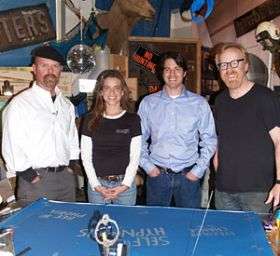With the help of Discovery Channel MythBusters Jamie Hyneman, left, and Adam Savage, right, two University of Wyoming archeologists tested the technological advantage of arrowheads in prehistoric cultures. Nicole Waguespack and Todd Surovell, middle, proposed that sharpened wooden arrows are as effective as arrows with chipped stone projectile points. (Photo courtesy Todd Surovell)
In the Stone Age, prehistoric peoples created weapons by making stone projectile points and affixing them to arrow and spear shafts. Until now, no one has researched the technological advantage or disadvantage of the arrowhead to prehistoric culture.
With the help of Discovery Channel MythBusters Jamie Hyneman and Adam Savage, two University of Wyoming archeologists pledged to find out about the arrowhead’s significance to ancient cultures.
Nicole Waguespack and Todd Surovell, both in the UW Department of Anthropology, a few years ago began to question the purpose of arrowheads. The objects had long been accepted in their profession as an important component of prehistoric weaponry.
The concept that projectile points were used to advance hunting has been perpetuated throughout history, but wasn't based on any meaningful evidence, according to the UW researchers.
"The importance of the arrowhead was a myth, so-to-speak," Waguespack says.
"Archeologists are absolutely obsessed with (projectile points). They are some of the prettiest things we find from the Stone Age and exemplify some of the more difficult objects to make," Surovell says. He adds those factors alone didn't make them significant.
"Nicole proposed that perhaps you didn't even need an arrowhead because a sharpened wooden arrow would do the trick. In fact, attaching the chipped stone projectile point to the end of an arrow adds more work to the production of the arrow," he says.
"It sounds really fundamental, but no one has ever explained why the projectile point makes an arrow or a thrown spear so much more effective. Is it the weight? Is it the fact it has a better cutting edge?" Waguespack says. "We find (arrowheads) all over the world in all times and places. It seems like a very basic question and archeologists should know why everyone made them."
While watching episodes of "MythBusters," a popular cable series that aims to separate truth from urban legend, Surovell and Waguespack realized the show could help shed light on Waguespack's hypothesis.
"It became very clear to us that this experiment was a pretty simple thing for them to do, they had all of the necessary equipment," Surovell explains.
He wrote an e-mail to Hyneman and proposed collaborating on the experiment. He didn't pitch the experiment for the show, but two weeks later, the researchers were invited to San Francisco to record the segment.
"For the show, Adam sharpened arrow shafts and Jamie tried to make a chipped stone projectile point. They timed each process, and discussed the fact that the pointy stick was a lot easier and faster to make," Waguespack says.
Then the team shot uniform arrows with and without arrowheads into a ballistics gel torso. The gel provided a consistent medium. A rig was used to fire the bow automatically and control draw tension. They measured each shot to see which weapon had greater penetration.
The UW researchers never intended for their experiment to be shown on television, they just wanted to take advantage of some hard-to-come-by equipment. Even so, Waguespack says the segment might serve a dual purpose: to resolve the questions about arrowheads' significance to prehistoric cultures, and to peak public interest in archeology.
"I think to have a little segment on the show questioning the use and benefits of arrowheads will make people more curious about artifacts and the questions archeologists face," Waguespack says. "We are trying to figure out how these things fit into the technological repertoire of prehistoric peoples."
So, how did the arrowhead fit into the technology of prehistoric peoples? To discover whether superiority of an arrow with an affixed projectile point was busted as a myth or confirmed as fact, tune into MythBusters. Visit discovery.com for a program schedule.
Source: University of Wyoming
























